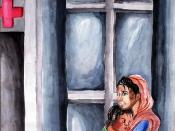Congress and President Bill Clinton created the State Children's Health Insurance Program (SCHIP) as part of the Balance Budget Act of 1997 (The American Medical Association, 2008). With the intention to give $24 billion in federal matching funds over a decade to state governments, within broad federal guidelines, for the provision of health insurance to about 5 million uninsured children, SCHIP would allow each State determines the design of its program, eligibility groups, benefit packages, payment levels for coverage, and management and operating procedures. SCHIP provides a capped amount of funds to States on a matching method for Federal fiscal years (FY) 1998 through 2007. Federal payments under title XXI to States are based on State expenditures under approved plans effective on or after October 1, 1997. This program was initially established to provide government-paid coverage for children whose parents are not poor enough to collect welfare and/or Medicaid; this included those children in families at or below 200 percent of the federal poverty line.
Eventually, SCHIP soon exceeded its purpose. By 2006, about 6.6 million children received SCHIP insurance benefits (The American Medical Association, 2008). Many of the children currently on SCHIP were previously insured through private coverage, which their parents dropped. Additionally, several states have set eligibility standards more than 200 percent of the federal poverty level and four of those have set it at 300 percent or higher (Hogberg, 2007). State governments were able to elevate the eligibility standard because the original SCHIP statute never set a specified poverty level for eligibility. Currently, a majority in Congress wants to make into law this violation of SCHIP intent. Both the House and Senate have passed bills that would allow families earning up to 400 percent of the federal poverty level to qualify for SCHIP benefits (Hogberg, 2007).
The Democratic Leadership Congress in 2007 proposed a large expansion of SCHIP that would have extended federal health insurance coverage to children in families making as much as $82,600 per year, which ultimately would of made up 71% of America's children eligible for federal health insurance assistance, a type of welfare (The National Center for Public Policy Research, 2007). Furthermore, the Congressional Leadership proposed funding this dramatic expansion with an overall increase in the tobacco tax. However, there is a realistic problem with this: if the amount of smokers dwindles, so would the funding for SCHIP. In addition, 22 million Americans would need to take up smoking to finance the expansion (The National Center for Public Policy Research, 2007), and that imposes taxes on the lower class. The expansion does not specifically focus on low-income children, but rather extends benefits to those clearly in the middle class and a few in the upper class. Providing near universal coverage for children, and funding it via cigarette taxes, is a critical step toward achieving a universal, government-run health care system, and using ÃÂchildrenÃÂ is a powerful advertising tool. Anyone who disagrees with providing coverage for children can be criticized as callous and cruel. On the other hand, cigarette taxes are one of the few types of taxes that the public will not fight because cigarettes are ÃÂbad.ÃÂWhile the development and overall success of how universal, government-run health care systems works in many other nations, is debatable, the United States should not allow SCHIP to be used as a stepping-stone toward such a system. SCHIP should be returned to its actual purpose of covering only children in families making no more than 200 percent of the poverty level. In addition, state lawmakers should not stay so narrowly focused on the prospect of more federal funds resulting from an SCHIP expansion that they often neglect to examine the costs to their states of matching those federal dollars. While an SCHIP expansion would certainly bring additional federal funding, states are likely to find themselves extending coverage to twice the amount of children that are currently uninsured due to the crowd-out effects inherent in public program expansions. According to the Department of Health and Human Services, ÃÂcrowd outÃÂ refers to a phenomenon whereby new federal programs or expansions of existing federal programs designed to expand coverage to the uninsured prompt some privately insured persons to drop their private coverage and take advantage of the expanded public subsidy. A preferable alternative would be for Congress to keep SCHIP focused on lower-income children and give a health care tax credit that could help middle-class families obtain or keep private health insurance.
Congress should enact a child health care tax credit, at least for those families between the 200 and 300 percent of the federal poverty line, to offer assistance to help them purchase private health insurance or retain the private coverage they currently have. The coverage could extend even further to 400 percent, and so forth, but a means of redistribution would have to be figured out. For example, Hogberg suggests that Congress could permit these families to claim a $1200 tax credit that could be effectively used to enroll their children in dependent coverage through an employer or the individual market. In addition, the credit should take place in two forms: a non-refundable tax credit and a refundable tax credit. The non-refundable tax credit would serve for taxpaying families, while a refundable tax credit would serve for families that do not pay enough in taxes to obtain a credit, which would be similar to a voucher. Hence, the two budget-neutral credits would level the playing fields for the families.
In balancing SCHIP with alternative policy ideas, it should increase children's coverage in a more effective and fairer way that the SCHIP expansion proposed. First, it would ensure that SCHIP is available for low-income, uninsured children. While the expansion would encompass the majority of children in the United States, members of Congress disagree over whether to extend the program for children in a different target population, that includes higher-income population, and to adults. Second, it would broaden access to private coverage for uninsured children. According to the Lewin Group, a healthcare policy research and management-consulting firm, initial estimates suggest that approximately 1.3 million uninsured children would gain private coverage if offered a tax credit. This would occur in addition to the children cover by a reauthorized SCHIP program. Third, it would protect existing private coverage for working families. According to the Congressional Budget Office, 77% of children between 200-300 percent of the federal poverty line already have private health insurance; however, many parents struggle to afford this coverage. Therefore, adopting a tax credit in this income bracket would assist parents and children to remain in the coverage originally chosen by the family. Finally, it would support initiatives to expand coverage at the state level, and give states an opportunity to establish better proposals to cover more people.
Although a vast deal of attention will be paid to the SCHIP reauthorization, Congress should take the opportunity to address broader health system problems. The high cost of health care is driving efforts in both the public and private sectors to enhance the functioning of the health system. Congress has an ideal opportunity to build upon those efforts with policies that promote better value for our health care dollars. Congress should aim to extend health coverage in such a way that does not disrupt families' current coverage and that helps those families who already are in jeopardy of losing private coverage. An "SCHIP-only" approach cannot achieve these goals. Current plans to fund SCHIP expansions with an overall increase in the tobacco tax would move more Americans further away from stable, affordable coverage. Taxing only cigarettes to fund higher spending on SCHIP has absolutely no basis in sound tax policy. Congress needs to develop alternatives that focus on low-income children, empower families to own their health insurance, and make affordable private coverage a reality for all.
ReferencesThe American Medical Association. (2008). What is SCHIP? Retrieved January 19, 2009, from The American Medical Association Website:http://www.ama-assn.org/ama1/upload/mm/16/schip.pdfHogberg, D. (2007). ÃÂSCHIP Expansion: Socialized Medicine on the Installment Plan.ÃÂ Retrieved January 22, 2009, from The National Center for Public Policy Research Website: http://www.nationalcenter.org/NPA560.htmlThe National Center for Public Policy Research. (2007). SCHIP Information Center. Retrieved January 22, 2009, from The National Center for Public Policy Research Website: http://www.schip-info.org/42.html


